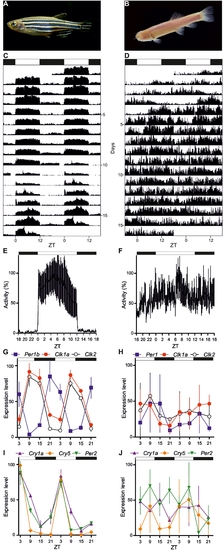- Title
-
A Blind Circadian Clock in Cavefish Reveals that Opsins Mediate Peripheral Clock Photoreception
- Authors
- Cavallari, N., Frigato, E., Vallone, D., Fröhlich, N., Lopez-Olmeda, J.F., Foà, A., Berti, R., Sánchez-Vázquez, F.J., Bertolucci, C., and Foulkes, N.S.
- Source
- Full text @ PLoS Biol.
|
Lack of rhythmicity in P. andruzzii under light dark cycles. Adult zebrafish (A) and P. andruzzii (B). (C,D) Representative actograms of zebrafish (C) and cavefish (D) maintained under LD conditions (each cycle: 12 h light, 12 h dark) and fed randomly. Records are double plotted on a 48 h time scale to aid interpretation; the y-axis progresses in single days with each day being plotted twice (day 1 on the right side is repeated on day 2 on the left side). The activity was binned every 10 min, the height of each point representing the number of interruptions of the infrared light beam. (E,F) Mean waveforms of zebrafish (E) and cavefish (F) are represented. Each point in the mean waveform has been calculated as the mean ± SEM from 10 min binned data across all the experimental days shown (n = 16) on each actogram and for all experimental aquaria (n = 6 for zebrafish and n = 6 for cavefish). For χ2 periodogram analysis (confidence level, 95%), see Figure S1. (G–J) Quantitative RT-PCR analysis of endogenous clock gene expression for 2 consecutive days in adult zebrafish and P. andruzzii fins (G,I and H,J, respectively; n = 6 per time point) exposed to 12:12 LD cycles. For all panels, each point represents the mean ± SEM. In P. andruzzii, neither clock-regulated (Per1 (blue), Clk1a (red), and Clk2 (black) (H)), nor light-regulated genes (Cry1a (purple), Cry5 (orange), and Per2 (green) (J)), show significant cycling (p>0.1) compared with high amplitude rhythms for the same genes observed in the zebrafish (p<0.0001) (panels G and I). White and black bars represent light and dark periods, respectively. On the y-axes are plotted relative expression levels, while on the x-axes time is expressed as zeitgeber time (ZT, where ZT0 represents lights on). |

